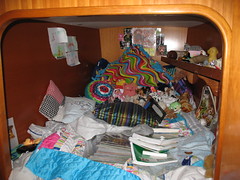We met a couple a few years ago preparing to leave for a year long cruise to Mexico. I liked both of them. I didn’t like their kids, but then again, I frequently don’t even like my own. The lot of them are too noisy, too fast, too sassy, and they get in my way. But never mind, the point is I thought we would bond with this couple. Here were two people in the middle of their lives with three small children and dream to sail the world on a catamaran. Who could be a better match?
Well maybe someone who isn’t dragged aboard.
There is an entire genre of the sailing literature to address the spouse dragged aboard by her sailing husband. The alternative is to sip high balls on the deck overlooking the golf course with the golf widows, and frankly any sensible woman would rather rot in hell. So these women accede to the pressures and cajoling of their loving partners, leave behind all their worldly goods, and step on to the deck of {insert husband’s dream boat here}.
God help these women because nothing else can. The problem is that hubby’s dream boat is inevitably an uncomfortable speedy tub with a smelly head, no storage space and an oven that doesn’t work. They are expected to cook, clean, and apparently put out. Repeatedly. Isn’t that what every captain deserves after a hard day of sailing upwind in the Trades? Uh, no. Not on our boat. There’ll be no putting out until he does the dishes at least.
I thought our friends had it made. She must have had some influence, because they were sailing out of our marina in MY dream boat: a beautiful, luxury 41 foot catamaran with enough space to play basketball in the saloon and complete with a dreamy 10’ Walker Bay dinghy. I drooled when I stepped on that boat. I could feel saliva pooling and my heart rate increase. I wanted that boat. I lusted for that boat. It had room for laundry, two Lewmar winches on either side of the cockpit, and a vacuum head with macerator.
But as we toured their boat, I felt a troubling sensation in the pit of my stomach. It took me awhile before I could put my finger on it. They had owned this boat for over a year. They were leaving in four months. I could not see a single sign that she existed on the craft. Anywhere. There was no evidence of her presence. When the discussion drifted to boat systems – as it inevitably does in the cruising world – she fell silent or played with her children.
I tested my hypothesis with a leading question, “So, you’ve had her for awhile now. How’s the oven? We’ve got a similar one, and I’m wondering what kind of performance you’re getting?”
She laughed and replied, “Oh, I have no idea. We’ve never used it.”
Blink.
The day before her husband left with the boat to ship it from Seattle down to San Francisco, she told me with delight, “I finally got into that sailing class I told you about!” The beginning sailing class. The class to begin. The first class. That class? The first class you take to learn how to sail. You’re leaving on a one year cruise of coastal Mexico in two weeks, and you’re just now enrolling in a sailing class?
I think she had a good time. They all returned alive. I understand that they basically spent their cruising season moving from marina to marina. Fortunately, yachtistas are a well cared for breed of migrating animal in Mexican cruising grounds. And let’s be clear, I believe they found a compromise that works for their boat and their needs. He has his boat and his cruise and his dream, and she lives on the dock. Even in Mexico.
But with this lesson in hand, I found myself doing three things immediately on delivery of our boat. First, I put pictures of the girls in the salon. Second, I ripped out every dog gamn deodorizer left by the former owner and burned Beanpod candles and incense for 2 days. Third, I started designing new curtains, cushion covers, and a bimini. In a fit of nesting – albeit in a floaty boaty sort of way – I scrubbed every bit of the interior, orange oiled every wood surface, and took apart both heads. I wasn’t satisfied that the boat was truly mine until I stood in manky bilge water and informed my captain that he needed to replace the water impeller before we lost the port engine.
As far as I’m concerned, you can be dragged aboard or you can piss on the tree and make your mark. It’s your territory, too.
Thursday, April 26, 2007
Thursday, April 19, 2007
We're Not All Cut Out for Homeschool
Author Note (5/3/07): If you arrived here from a homeschool site, brace yourself. The articles in this blog are authored by a freelance humor columnist whose primary objective is to sell articles to sailing magazines that poke fun at cruising, sailing, cooking in the joke of a kitchen known as a galley, families trying something out of the box, and all things related to spending absurd amounts of money on boat gear. This article should not be interpreted as an advisory for those considering the homeschool world. And whatever you do, ignore #7. And maybe #8. And just for giggles, pretend that you didn't read the one about perfectionists either.
“It’s different for every homeschool family,” Polly reassures a parent who is visiting the Seattle Homeschool Resource Center today to learn more about what it’s like to homeschool. Polly, mother of six and matron of the SHRC, knows what she’s talking about. She’s seen families flow through this program for years now. The answer to the question of, “What is it like to homeschool?” is pretty much a non-starter.
I think answering that question is a lot like trying to explain to people who have no children what it’s like to bring a baby into the world for the first time. It’s the best thing in the world! It’s the worst! It’s all that, and it’s not like that at all. What can I say? You are blind, you’re asking me to describe the difference between mauve and magenta, and I’m not even sure you know what a color is. We may have no common reference point.
I don’t feel like reassuring this homeschool-teacher-to-be. I feel like shouting, “RUN! Run away NOW! You are not the ideal candidate for homeschooling.”
Okay, but why? Naturally, the instant the prospect left the Commons, the room erupted in what Polly has both optimistically and euphemistically referred to as one of our “supportive conversations about homeschooling and parenting” but to which most of us parents refer as our “gossiping sessions.” We parents are required by law to be on the grounds of the school while our offspring participate in the Seattle School District's answer to the ever increasing numbers of children escaping public school. Rather than give up that money, they’ve created a place where they can entice us back into the “system” with art, drama, music, and advanced math classes. For this we are paid $400 a child and they are paid $8,000 by the State. Our kids expand their minds, and we chit chat and drink coffee.
Anyway, there was a surprisingly high degree of consensus that my opinion of the prospect was spot on. She’ll probably make a lousy transition to a homeschool parent. This then led to a long discussion about what makes a homeschool family unsuccessful. So much for supportive, helpful comments about homeschooling by experienced parents. So to those in the F cube (friends, family and fans) seeking recommendations and advice on the topic of homeschooling, I offer this list from the parents of SHRC:
Reason 1) You believe that socializing is the most important job of public school.
Since this is always the first question “inquiring minds" want to know, I can only assume this is important. No one asks me how I’m going to teach the kids to read, conjugate verbs, or dissect frogs, so presumably they trust in my ability to convey those important skills. I would like to point out, however, that what public school socializes your children to do is spend six hours sitting in a room with twenty-nine other people the same age during which they must pee and eat at the same time as well as line up to move from room to room. If you know of any place but public school where this would be a useful skill, you let me know.
Reason 2) You send email to a complete stranger on the Internet asking which curriculum you should use.
Not to discourage the fan mail… I LOVE it! I thrill to receiving email from all of you – particularly those that I don’t know and who do not share my last name. However, I’ve received questions like: “Do you think I should use Sonlight or Abeka?” First, I have no clue. I don’t know what your kids are like. Second, I’m not a Christian. Don’t ask me to differentiate between books that teach the world is either 3,000 or 6,000 years old. It’s like asking a teetotaler to discuss the relative merits of gin versus vodka.
Reason 3) You have an obsessive need for one or more of the following: Cleanliness, peace, or privacy.
Actually, you probably shouldn’t even have had children. But if the barn door has already swung open on that one, don’t compound your initial error by bringing all that cacophony into your home 24/7.
Reason 4) You don't like your children.
See Reason 3.
Reason 5) You want to watch movies and play Sudoku all day.
Believe it or not, “Homeschool Parent” is a full time job. You may think that once you settle in with the kids at home you won’t be “working” and therefore you’ll have all the time in the world to write a novel, knit a sweater, or get a master’s degree in existential thought in the 21st century. I am here to assure you that you will have less time to yourself and your own pursuits as a homeschool teacher than you did back in your software development days when you routinely clocked 65 hours a week and synchronized your laptop in the delivery room.
Reason 6) You have impulse control problems.
The opportunities for disaster are endless.
Reason 7) You have only one child.
Okay, this isn't a reason, this is just a heads up. We onlies are an arrogant lot, bright and strong willed. We're tricky beasts. Be vawy vawy cautious when you twap one of us waskaly devils in your house.
Reason 8) The world revolves around either you or your child.
It does not pay to let anyone believe for more than a few minutes that he or she is the most important person in the world. From such lapses of reality, monomaniacal world leaders are created.
Reason 9) You are a perfectionist. Your spouse is a perfectionist. Your child is a perfectionist. Your parents are perfectionists.
Inevitably, you will disappoint someone.
And, last but not least…
Reason 10) …
Never mind. We don’t have a reason ten. About two weeks into it, you’ll come up with your own reason ten.
“It’s different for every homeschool family,” Polly reassures a parent who is visiting the Seattle Homeschool Resource Center today to learn more about what it’s like to homeschool. Polly, mother of six and matron of the SHRC, knows what she’s talking about. She’s seen families flow through this program for years now. The answer to the question of, “What is it like to homeschool?” is pretty much a non-starter.
I think answering that question is a lot like trying to explain to people who have no children what it’s like to bring a baby into the world for the first time. It’s the best thing in the world! It’s the worst! It’s all that, and it’s not like that at all. What can I say? You are blind, you’re asking me to describe the difference between mauve and magenta, and I’m not even sure you know what a color is. We may have no common reference point.
I don’t feel like reassuring this homeschool-teacher-to-be. I feel like shouting, “RUN! Run away NOW! You are not the ideal candidate for homeschooling.”
Okay, but why? Naturally, the instant the prospect left the Commons, the room erupted in what Polly has both optimistically and euphemistically referred to as one of our “supportive conversations about homeschooling and parenting” but to which most of us parents refer as our “gossiping sessions.” We parents are required by law to be on the grounds of the school while our offspring participate in the Seattle School District's answer to the ever increasing numbers of children escaping public school. Rather than give up that money, they’ve created a place where they can entice us back into the “system” with art, drama, music, and advanced math classes. For this we are paid $400 a child and they are paid $8,000 by the State. Our kids expand their minds, and we chit chat and drink coffee.
Anyway, there was a surprisingly high degree of consensus that my opinion of the prospect was spot on. She’ll probably make a lousy transition to a homeschool parent. This then led to a long discussion about what makes a homeschool family unsuccessful. So much for supportive, helpful comments about homeschooling by experienced parents. So to those in the F cube (friends, family and fans) seeking recommendations and advice on the topic of homeschooling, I offer this list from the parents of SHRC:
Ten Reasons Why You Shouldn’t Homeschool
Reason 1) You believe that socializing is the most important job of public school.
Since this is always the first question “inquiring minds" want to know, I can only assume this is important. No one asks me how I’m going to teach the kids to read, conjugate verbs, or dissect frogs, so presumably they trust in my ability to convey those important skills. I would like to point out, however, that what public school socializes your children to do is spend six hours sitting in a room with twenty-nine other people the same age during which they must pee and eat at the same time as well as line up to move from room to room. If you know of any place but public school where this would be a useful skill, you let me know.
Reason 2) You send email to a complete stranger on the Internet asking which curriculum you should use.
Not to discourage the fan mail… I LOVE it! I thrill to receiving email from all of you – particularly those that I don’t know and who do not share my last name. However, I’ve received questions like: “Do you think I should use Sonlight or Abeka?” First, I have no clue. I don’t know what your kids are like. Second, I’m not a Christian. Don’t ask me to differentiate between books that teach the world is either 3,000 or 6,000 years old. It’s like asking a teetotaler to discuss the relative merits of gin versus vodka.
Reason 3) You have an obsessive need for one or more of the following: Cleanliness, peace, or privacy.
Actually, you probably shouldn’t even have had children. But if the barn door has already swung open on that one, don’t compound your initial error by bringing all that cacophony into your home 24/7.
Reason 4) You don't like your children.
See Reason 3.
Reason 5) You want to watch movies and play Sudoku all day.
Believe it or not, “Homeschool Parent” is a full time job. You may think that once you settle in with the kids at home you won’t be “working” and therefore you’ll have all the time in the world to write a novel, knit a sweater, or get a master’s degree in existential thought in the 21st century. I am here to assure you that you will have less time to yourself and your own pursuits as a homeschool teacher than you did back in your software development days when you routinely clocked 65 hours a week and synchronized your laptop in the delivery room.
Reason 6) You have impulse control problems.
The opportunities for disaster are endless.
Reason 7) You have only one child.
Okay, this isn't a reason, this is just a heads up. We onlies are an arrogant lot, bright and strong willed. We're tricky beasts. Be vawy vawy cautious when you twap one of us waskaly devils in your house.
Reason 8) The world revolves around either you or your child.
It does not pay to let anyone believe for more than a few minutes that he or she is the most important person in the world. From such lapses of reality, monomaniacal world leaders are created.
Reason 9) You are a perfectionist. Your spouse is a perfectionist. Your child is a perfectionist. Your parents are perfectionists.
Inevitably, you will disappoint someone.
And, last but not least…
Reason 10) …
Never mind. We don’t have a reason ten. About two weeks into it, you’ll come up with your own reason ten.
Thursday, April 12, 2007
Taming the Stuff Beast
In January 2005, Dr C and I came to the conclusion that our lives were perfect in every way. Obviously it was time to take a 90-degree turn and do something else. Peace, great jobs, privacy, beautiful home, gorgeous healthy children notwithstanding, we weren’t particularly happy. There just wasn’t enough time in the day to be both rich and sexually satisfied. We can talk about noble aspirations to spend more time with the children, have an adventure, see the world. But what it was really all about is getting more and getting it more frequently.
At least for him.
Okay, for me too.
The first thing that became clear is we had too much Stuff. Having lived for nearly a decade in the same place, we possessed so many things we had filled our house, our garage, Dr C’s business storeroom, and the laundry room. We had things in cupboards and items in drawers. We even had Stuff that had its own stuff, like the vintage Mustang in the garage that had its own set of tools, battery charger, and spare parts inventory.
So we embarked on a furious weekend of purging. Yes, purging. This is the process in which you poke a stick into your house, and it vomits up bags of old clothes and dusty kitchen gear. Out came half packages of diapers (last child potty trained in 2002), toddler bed sheets, and three entire bags of baby toys. We unearthed unmailed Christmas cards from 2003 and a bag of bathroom supplies gathered at the last minute from our house in Philadelphia and stuck in a drawer in the bathroom in Seattle when we moved in ten years ago. Nine mini-vans full of “stuff” went to the dump or the Salvation Army, and I spent two furiously spam-filled weeks during which we freecycled enough junk to fill a yard sale.
Brushing our hands off, we looked around at the newly cleared house smugly, pleased that we had already taken a first, critical step in simplifying our lives. The problem came six months later when we were once again carefully threading our way through the basement, stepping over and around boxes and boxes of Stuff.
There is only one, inescapable conclusion to be drawn from this experience: Your Stuff is alive.
Once you accept this, you can easily accept the corollary: Your Stuff breeds.
Stuff multiplies, it divides and spreads like ooze over the healthy patina of organizational simplicity. It creeps into open drawers and between gaps in the suits in your closet. And like roses harshly pruned in the winter to encourage vibrant new growth in the spring, your Stuff rises to the challenge of the occasional purge. It surges up in a tidal wave of unused kitchen gadgets, boxes of high school memorabilia and unopened cans of refried beans purchased at rock bottom prices from Costco in a mercurial flurry of penny pinching.
If you attack your Stuff, it fights back. This is not a single campaign, mind you. It’s a war, and I am calling on all of you! Rise up and challenge this beast! Do not be fooled by the promises of mercenary soldiers in this war such as California Closet and Ikea, promising a neat and tidy solution. Ultimately, beating back your Stuff is a day-to-day, ground-level encounter that requires constant vigilance and steady nerve. You can’t do it in one weekend. In fact, we simplified our lives in fitful waves as my temper blew at tripping over something for the umpteenth time.
Our most recent and frantic reduction in worldly goods came as we moved into the basement. We found tenants to take the top and main levels of the house while we consolidated into the bottom floor and on to our boat for the summer. While the basement is roughly twice the square footage of the boat, it is still a very small place. There is no room for Stuff. Everything needed to have at least two, if not four to seven, useful functions or it didn’t survive my latest scrimmage against it.
There are two bits of good news: 1) We fit in on the boat and 2) the total book value of what we donated to tax deductible charities this year will far exceed our annual income. The bad news is that I heard a rustling noise in the laundry room where Dr C has been stashing his “important tools.”
I think the Stuff is organizing for a comeback.
At least for him.
Okay, for me too.
The first thing that became clear is we had too much Stuff. Having lived for nearly a decade in the same place, we possessed so many things we had filled our house, our garage, Dr C’s business storeroom, and the laundry room. We had things in cupboards and items in drawers. We even had Stuff that had its own stuff, like the vintage Mustang in the garage that had its own set of tools, battery charger, and spare parts inventory.
So we embarked on a furious weekend of purging. Yes, purging. This is the process in which you poke a stick into your house, and it vomits up bags of old clothes and dusty kitchen gear. Out came half packages of diapers (last child potty trained in 2002), toddler bed sheets, and three entire bags of baby toys. We unearthed unmailed Christmas cards from 2003 and a bag of bathroom supplies gathered at the last minute from our house in Philadelphia and stuck in a drawer in the bathroom in Seattle when we moved in ten years ago. Nine mini-vans full of “stuff” went to the dump or the Salvation Army, and I spent two furiously spam-filled weeks during which we freecycled enough junk to fill a yard sale.
Brushing our hands off, we looked around at the newly cleared house smugly, pleased that we had already taken a first, critical step in simplifying our lives. The problem came six months later when we were once again carefully threading our way through the basement, stepping over and around boxes and boxes of Stuff.
There is only one, inescapable conclusion to be drawn from this experience: Your Stuff is alive.
Once you accept this, you can easily accept the corollary: Your Stuff breeds.
Stuff multiplies, it divides and spreads like ooze over the healthy patina of organizational simplicity. It creeps into open drawers and between gaps in the suits in your closet. And like roses harshly pruned in the winter to encourage vibrant new growth in the spring, your Stuff rises to the challenge of the occasional purge. It surges up in a tidal wave of unused kitchen gadgets, boxes of high school memorabilia and unopened cans of refried beans purchased at rock bottom prices from Costco in a mercurial flurry of penny pinching.
If you attack your Stuff, it fights back. This is not a single campaign, mind you. It’s a war, and I am calling on all of you! Rise up and challenge this beast! Do not be fooled by the promises of mercenary soldiers in this war such as California Closet and Ikea, promising a neat and tidy solution. Ultimately, beating back your Stuff is a day-to-day, ground-level encounter that requires constant vigilance and steady nerve. You can’t do it in one weekend. In fact, we simplified our lives in fitful waves as my temper blew at tripping over something for the umpteenth time.
Our most recent and frantic reduction in worldly goods came as we moved into the basement. We found tenants to take the top and main levels of the house while we consolidated into the bottom floor and on to our boat for the summer. While the basement is roughly twice the square footage of the boat, it is still a very small place. There is no room for Stuff. Everything needed to have at least two, if not four to seven, useful functions or it didn’t survive my latest scrimmage against it.
There are two bits of good news: 1) We fit in on the boat and 2) the total book value of what we donated to tax deductible charities this year will far exceed our annual income. The bad news is that I heard a rustling noise in the laundry room where Dr C has been stashing his “important tools.”
I think the Stuff is organizing for a comeback.
Thursday, April 05, 2007
The Most Important Purchase of Your Life
I cannot even begin to tell you how important it is that you select the proper boat for cruising. This may be the single most significant decision of your entire life. It’s more important than selecting a college major, more difficult than finding your life mate, and presents you with more diversity of choice than the beverage options at Starbuck’s. And your very life depends on your selection.
Let me repeat that with a virtual, concussive reverberation machine: Your very life depends on your selection…selection…selection….
There are Rules on how to do this. The Rules in this case consist of the long list of salty sailor instructions regarding the fine art of boat selection. There are literally hundreds of helpful articles and even entire books devoted to the subject of selecting your perfect cruising boat.
Among the considerations you should apparently noodle are items such as seaworthiness, speed, performance, availability of parts, hull material, rigging configuration, and construction quality. Depending on which multi-bazillion-mile sailor you read, you should either purchase the largest, roomiest most comfortable boat you can afford, or you should purchase the smallest, most cost effective boat you can stand. Most agree you should start with a smaller boat, learn how to sail, and get your feet wet – as it were – before you consider the purchase of your cruising boat.
When you find a boat style you think will do, you charter a sister ship and go on test sails. See if you can spend a week aboard a boat of a similar size and conformation. Talk to people who own these boats. Get on their Yahoo mailing list and read the entire archive back to the founding of the American colonies.
Then locate your first candidate boat. Go on a sea trial and have an extensive survey. Insist on seeing the logs since the hull was laid. Open every thru hull and rummage through all the lockers. Tap on every square inch of the fiberglass to find bubbles and haul the boat to check every bit of the bottom for blistering.
THEN… then and only then should you consider buying your cruising boat.
Good luck with all that.
I can’t tell you how important this process is because … well…
It happened like this. Skip the reason why for another article and get to the sailing experience. Dr C sailed with his father in circles on the family’s Valiant 42 out of Newport Beach as a teen and pretty much loathed the futility of circular travel itineraries and bashing around at a 25-degree angle off the Pacific coast. My entire nautical experience consisted of seven days on a sail boat in the San Juan Islands, three days on the Disney Cruise Ship, and an inebriated summer in high school spent tubing the American River.
When it came time to buy a boat, he wanted a multi-hull, probably because it was about as far from his dad’s deep-keeled sea worthy gem as possible. I wanted something with enough room to avoid my children. The kids wanted a slide. Five minutes, tops, to select the category Cruising Catamaran.
Moving on, once you decide on a multi-hull two things happen. First, the number of tips offered by salty sailors drops from a million to one: “Don’t do it. Catamarans are not as safe as monohulls.” It’s a relief, really, because once the support network of experienced sailors starts to turn negative on you, it’s easy to dismiss nearly everything else they recommend. The second thing that happens is that the number of boats available to you goes from one million to one – especially if you live on the Pacific west coast and don’t want to have a boat shipped all the way from Europe or South Africa. The total number of used catamarans on the market out here at any given time varies between three and fifteen. You think I’m joking? Go check out Yacht World.
Note: Yacht World is to wannabe cruisers as the Liquor Barn is to an alcoholic. Follow this link at your own risk.
We browsed around and looked at lots of pretty pictures of catamarans, took a Fountain Pajout out for a day sail, ogled a Lagoon 410 on the dock, and then bought sight unseen the first Lagoon 380 that came on the market in the Pacific Northwest… pending sea trial and survey yadda yadda yadda. Whatever.
But don’t let this experience mislead you! Do as I say, not as I do! Because if you run off and buy the boat without proper preparation and evaluation you might end up like us. You, too, could be living happily on a gorgeous, well founded cruising sailboat bobbing at a dock in Elliott Bay watching the sunset glint off the Seattle skyline while sipping mai tais.
A fate worse than …um… I’m drawing a blank here.
Let me repeat that with a virtual, concussive reverberation machine: Your very life depends on your selection…selection…selection….
There are Rules on how to do this. The Rules in this case consist of the long list of salty sailor instructions regarding the fine art of boat selection. There are literally hundreds of helpful articles and even entire books devoted to the subject of selecting your perfect cruising boat.
Among the considerations you should apparently noodle are items such as seaworthiness, speed, performance, availability of parts, hull material, rigging configuration, and construction quality. Depending on which multi-bazillion-mile sailor you read, you should either purchase the largest, roomiest most comfortable boat you can afford, or you should purchase the smallest, most cost effective boat you can stand. Most agree you should start with a smaller boat, learn how to sail, and get your feet wet – as it were – before you consider the purchase of your cruising boat.
When you find a boat style you think will do, you charter a sister ship and go on test sails. See if you can spend a week aboard a boat of a similar size and conformation. Talk to people who own these boats. Get on their Yahoo mailing list and read the entire archive back to the founding of the American colonies.
Then locate your first candidate boat. Go on a sea trial and have an extensive survey. Insist on seeing the logs since the hull was laid. Open every thru hull and rummage through all the lockers. Tap on every square inch of the fiberglass to find bubbles and haul the boat to check every bit of the bottom for blistering.
THEN… then and only then should you consider buying your cruising boat.
Good luck with all that.
I can’t tell you how important this process is because … well…
It happened like this. Skip the reason why for another article and get to the sailing experience. Dr C sailed with his father in circles on the family’s Valiant 42 out of Newport Beach as a teen and pretty much loathed the futility of circular travel itineraries and bashing around at a 25-degree angle off the Pacific coast. My entire nautical experience consisted of seven days on a sail boat in the San Juan Islands, three days on the Disney Cruise Ship, and an inebriated summer in high school spent tubing the American River.
When it came time to buy a boat, he wanted a multi-hull, probably because it was about as far from his dad’s deep-keeled sea worthy gem as possible. I wanted something with enough room to avoid my children. The kids wanted a slide. Five minutes, tops, to select the category Cruising Catamaran.
Moving on, once you decide on a multi-hull two things happen. First, the number of tips offered by salty sailors drops from a million to one: “Don’t do it. Catamarans are not as safe as monohulls.” It’s a relief, really, because once the support network of experienced sailors starts to turn negative on you, it’s easy to dismiss nearly everything else they recommend. The second thing that happens is that the number of boats available to you goes from one million to one – especially if you live on the Pacific west coast and don’t want to have a boat shipped all the way from Europe or South Africa. The total number of used catamarans on the market out here at any given time varies between three and fifteen. You think I’m joking? Go check out Yacht World.
Note: Yacht World is to wannabe cruisers as the Liquor Barn is to an alcoholic. Follow this link at your own risk.
We browsed around and looked at lots of pretty pictures of catamarans, took a Fountain Pajout out for a day sail, ogled a Lagoon 410 on the dock, and then bought sight unseen the first Lagoon 380 that came on the market in the Pacific Northwest… pending sea trial and survey yadda yadda yadda. Whatever.
But don’t let this experience mislead you! Do as I say, not as I do! Because if you run off and buy the boat without proper preparation and evaluation you might end up like us. You, too, could be living happily on a gorgeous, well founded cruising sailboat bobbing at a dock in Elliott Bay watching the sunset glint off the Seattle skyline while sipping mai tais.
A fate worse than …um… I’m drawing a blank here.
Subscribe to:
Comments (Atom)








